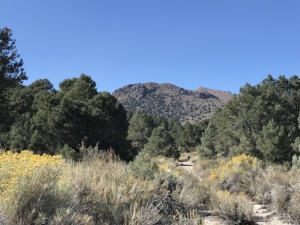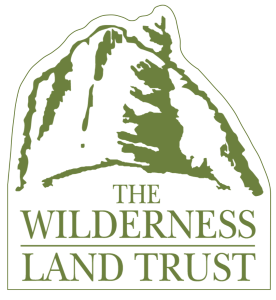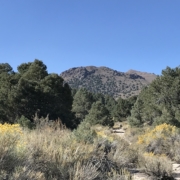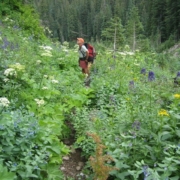By Paul Torrence, board member, The Wilderness Land Trust
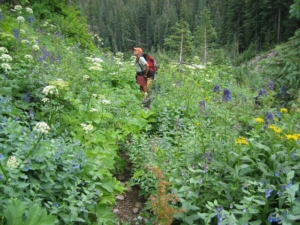
Lupine and cow parsnip are examples of some of the floral biodiversity found in the La Garita Wilderness in Colorado’s San Juan Mountains. Above, Paul Torrence hikes the trail to San Luis Peak in the La Garita.
Jan. 7, 2022 – The global conservation community and life on earth suffered a monumental loss in the closing days of 2021 with the deaths of two conservation giants – Professor Edward O. Wilson and
Professor Thomas E. Lovejoy III.
There will be scores of articles and eulogies written in many different languages about their scientific accomplishments, massive contributions to humans and the natural world, and legendary advocacy for biological diversity.
As a member of the board of directors for The Wilderness Land Trust, I honor these two tireless nature advocates and their support for our work at the Trust.
The Diversity of Life (1988) was the first book of Professor Wilson’s that I read. I was so fascinated by this book that I carried it with me on my daily trips aboard the Washington DC subway to work at the National Institutes of Health. I carried it with me again in the mid 1990s to a lecture by Professor Wilson at the National Zoo. I was one of probably 400 attendees who were awed by his articulate and profoundly thoughtful speech.
At the conclusion of his talk, I joined several dozen people who were attempting to introduce themselves to him. When the crowd finally dispersed, I was able to shake his hand and ask for his indulgence to write a passage in my book. He went a step further, spending some 10 minutes talking with me about the relationship of biodiversity and the biomedical research done at the National Institutes of Health, and then provided good counsel on available opportunities for my children as they developed their interests in environmental sciences.
A remarkably kind and generous man, he will be desperately missed. I encourage you to watch Professor Wilson’s video, Future of Life.
“Congratulations to The Wilderness Land Trust on its 20th anniversary. There is no better way to save biodiversity than by preserving habitat, and no better habitat, for species, than wilderness.”
–Edward O. Wilson, speaking in 2012 about the Wilderness Land Trust’s 20th anniversary.
A second seemingly near mortal blow to the battle to conserve biodiversity comes from the premature death of Dr. Thomas E Lovejoy, a tireless advocate for biodiversity and incredibly accomplished scientist.
I am honored to have met him and even more honored that he provided an endorsement of my book, “Molecules of Nature.” It was such a remarkable endorsement and I continue to work hard to live up to his words. Dr. Lovejoy never failed to answer my emails with the exception of a six-week period when he was in the Brazilian Amazon conducting ecological research. I figured he’d finally had enough of me, but he emailed upon his return! I encourage you to watch this video celebrating Professor Lovejoy’s work.
“For two decades The Wilderness Land Trust has piece by piece added to the long-term security not only of wilderness areas but also to the ecological security of the planet. And this is just a beginning for what the Trust can do.”
–Thomas E. Lovejoy, speaking in 2012 about the Trust’s 20th anniversary.
I felt very alone as I sat down to write this, remembering the loss of board member Jean Hocker in 2019, conservationist Michael Soule in 2020, board member Jim Babbitt in 2021, and now Professor Wilson and Professor Lovejoy. Who remains on this ride? Who will tell us to put on the brakes? Who will guide us through the next hairpin turn? And then I remembered. Professors Wilson and Lovejoy, through their writing, public advocacy, teaching and mentorship, have recruited and launched thousands of students into careers in the biological sciences, conservation policy, and biodiversity advocacy. With them resides the future of biodiversity and life on Earth.
Moreover, I have aligned and surrounded myself with free thinking individuals who have traveled different trails and come to the same place as I have: The recognition of the inherent value of the wild and all of the most beautiful and most wonderful species that share this planet.
I am grateful for my colleagues – the board of directors and staff of The Wilderness Land Trust. And I am also grateful to our members and supporters and all those who care so passionately about the community of life.
Our sister organization, Rainforest Trust, enjoyed the presence of Ed and Tom on their board of directors. One passage from a recent email from the Rainforest Trust is worth repeating here:
“Tom and Ed kept us focused on the most critical job in conservation, protecting habitat, even while many conservation NGOs lost their focus. You and I both know what they would tell us to do now — stick to the mission, stay the course, put one foot in front of the other. Act, urgently, to save species and climate. They are gone. The job is up to us.”
-The Rainforest Trust
About Professor Edward O. Wilson
Professor Wilson was a university research professor emeritus, Harvard University; twice Pulitzer Prize winner; U.S. National Medal of Science recipient; and Time Magazine’s 25 Most Influential People in America, 1995. He was also a renowned author of multiple books, including The Theory of Island Biogeography, Sociobiology: The New Synthesis, On Human Nature, Biophilia, The Ants, Consilience, The Future of Life, The Creation: An Appeal to Save Life on Earth, Half Earth: Our Planets Fight for Life.
About Professor Thomas E. Lovejoy
Thomas E. Lovejoy was a university professor at George Mason University, Biodiversity; chair, Heinz Center for Science, Economics and the Environment; founder of the PBS series Nature; a former senior advisor to the president of the United Nations; assistant secretary for Environmental and External Affairs for the Smithsonian Institution; and executive vice president of World Wildlife Fund – U.S. He also coined the term, “Biological Diversity.”
About Paul Torrence
Paul Torrence began his wilderness odyssey in 1970 when he helped scout potential wilderness areas in Shenandoah National Park in the run–up to the passage of the Eastern Wilderness Areas act (1975). He has hiked, backpacked, and climbed in wilderness from New Hampshire’s White Mountains and New York’s Adirondacks to the lush, biodiverse Southern Appalachians. Not content with only eastern wilderness, Paul has also climbed in Alaska’s Brooks Range, run the Hula Hula River to the Arctic Ocean, climbed the great volcanoes of the Cascades, traversed the high peaks of Wyoming’s Wind River Mountains and summited more than half of Colorado’s fourteeners.
For 30 years, Paul employed his PhD in chemistry to research cancer and virus diseases at the National Institutes of Health. He then became a professor at Northern Arizona University in Flagstaff, where he is now emeritus professor. He has published more than 200 scientific papers and edited four volumes in drug discovery and medicinal chemistry. Most recently he authored, “Molecules of Nature: Biodiversity, the Sixth Mass Extinction, and the Future of Medicine.”
